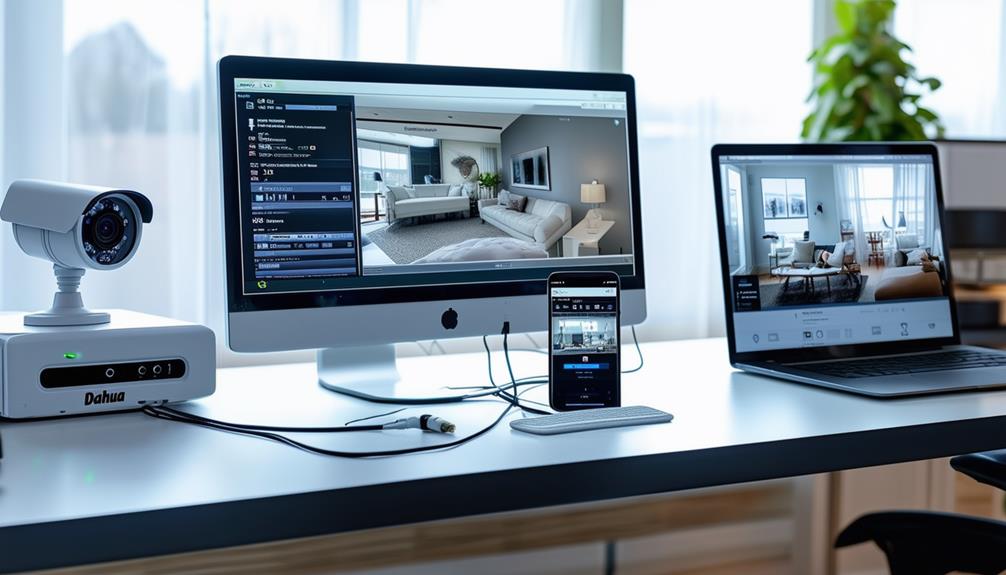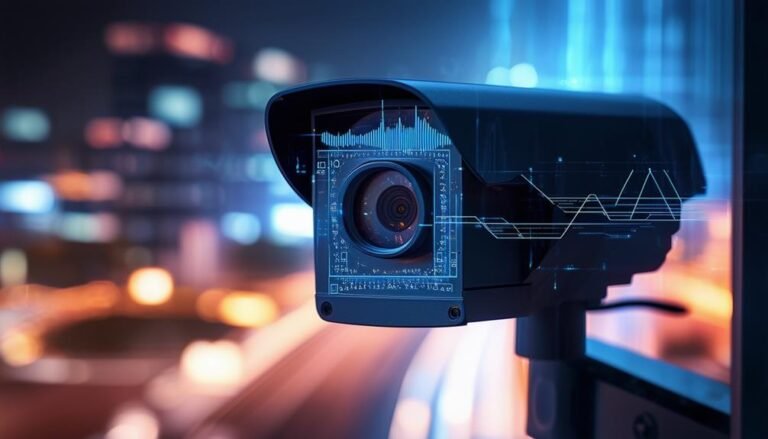To configure your Dahua DVR for remote viewing, start by connecting it to your network using an Ethernet cable. Next, access the DVR settings, select “Network,” and set up either DHCP or a static IP address. Then, configure port forwarding on your router for ports 37777 (HTTP) and 8000 (RTSP). Download the Dahua app on your mobile device, and add your DVR by entering its IP address and port. Finally, verify your account settings and test the connection. Follow these steps, and you’ll be set to monitor your footage anytime, anywhere. There’s more to explore, so keep going!
Understanding Remote Viewing
Understanding remote viewing is essential for anyone looking to access their Dahua DVR from afar. It’s about gaining the freedom to monitor your security system without being physically present. Imagine being able to check in on your property while you’re on vacation or at work. The power of remote viewing lets you do just that, offering peace of mind and control wherever you are.
At its core, remote viewing involves connecting your DVR to the internet. This connection allows you to tap into live feeds and recorded footage from your cameras using a smartphone, tablet, or computer. It’s an empowering experience, as you can stay informed and responsive to any security concerns in real time. With the right setup, you’re not bound to your home; you can roam freely, knowing your property is being monitored.
Moreover, remote viewing enhances your ability to respond to incidents quickly. If you see something unusual, you can take action right away, whether it’s alerting authorities or informing neighbors. The convenience of accessing your DVR remotely also means you can review past footage whenever necessary, helping you stay vigilant and aware.
In short, mastering remote viewing transforms how you interact with your security system. It’s not just about surveillance; it’s about reclaiming your freedom and ensuring your space remains safe, regardless of where life takes you. Embrace this technology, and enjoy the peace of mind that comes with it.
Required Equipment and Software
To set up remote viewing on your Dahua DVR, you’ll need some essential hardware components and specific software applications. Getting these items right is vital for a seamless experience. Let’s break down what you’ll need to get started.
Essential Hardware Components
When setting up a Dahua DVR for remote viewing, you’ll need a few essential hardware components and software. First, make certain you have a reliable power supply to keep your DVR running smoothly. A surge protector is also a good idea to safeguard against power spikes.
Next, you’ll need a quality network router. This device will connect your DVR to the internet, allowing you to access your security footage remotely. Wired connections are often more stable, so consider using Ethernet cables to link the DVR directly to your router.
Don’t forget about storage! A hard drive with ample space is necessary for saving your recorded footage. The capacity you choose depends on how long you want to keep recordings before they overwrite.
Lastly, make certain you have a compatible monitor or screen to configure your DVR settings initially. While this setup allows you to access your system locally, it’s vital to have a smartphone or computer for remote viewing later on. With the right hardware in place, you’ll be ready to enjoy the freedom of monitoring your property from anywhere!
Necessary Software Applications
Having the right software applications is essential for effectively configuring your Dahua DVR for remote viewing. These applications will not only help you manage your device but also give you the freedom to access your security footage from anywhere. Here are some crucial software applications you’ll need:
| Application | Purpose | Platform |
|---|---|---|
| Dahua Smart PSS | Main management software for DVRs | Windows, Mac |
| DMSS | Mobile viewing and management | iOS, Android |
| VLC Media Player | Viewing video files | Windows, Mac, Linux |
| Web Browser | Accessing DVR via web interface | Any (Chrome, Firefox) |
Connecting Your DVR to the Network
Connecting your DVR to the network is crucial for enabling remote viewing capabilities. Without this step, you won’t be able to access your surveillance footage from anywhere, and that can limit your freedom to monitor your property. To get your DVR online, follow these straightforward steps:
- Choose Your Connection Type: Decide whether you want to connect your DVR via Ethernet or Wi-Fi. An Ethernet connection is generally more stable, while Wi-Fi offers more flexibility in placement.
- Connect Your DVR: If you’re using Ethernet, plug one end of the cable into the DVR and the other into your router. For Wi-Fi, access your DVR’s settings using a monitor and a mouse. Navigate to the network settings and select your Wi-Fi network, entering the password when prompted.
- Verify Connection: Once connected, check to confirm your DVR is communicating with the network. You can do this by looking for network status indicators on the DVR’s screen or accessing the device through your local network.
Configuring DVR Settings
Now that you’ve connected your DVR to the network, it’s time to configure the settings for ideal remote viewing. You’ll need to set up the network connection, configure port forwarding, and guarantee you can access your DVR through the mobile app. Let’s go through each of these steps to get everything running smoothly.
Network Connection Setup
Setting up a network connection is vital for enabling remote viewing on your Dahua DVR. Without a proper connection, you won’t be able to access your surveillance feed from anywhere. Here’s how to configure your network settings effectively:
- Connect the DVR: Start by connecting your DVR to your router using an Ethernet cable. This physical link is essential for your network setup.
- Access Network Settings: Navigate to the DVR’s main menu, go to “Settings,” and select “Network.” Here, you’ll find options to configure your connection type.
- Configure IP Address: Choose between DHCP (automatic) or Static IP. If you want more control, opt for Static IP, as it gives you a fixed address for easier access.
Once you’ve completed these steps, double-check your settings to verify everything’s correct. Testing your connection is vital—try accessing the DVR via a web browser or mobile app. If all’s set, you’ll enjoy the freedom to monitor your property anytime, anywhere. Embrace this capability to enhance your security!
Port Forwarding Configuration
With your network connection properly established, the next step is configuring port forwarding on your router. This allows external devices to communicate with your Dahua DVR securely. To do this, you’ll need to access your router’s settings. Typically, you can do this through a web browser using your router’s IP address.
Here’s a simple table to guide you through the necessary port forwarding settings:
| Setting | Value |
|---|---|
| Service Name | DVR |
| Internal IP | Your DVR’s IP |
| Internal Port | 37777 |
| Protocol | TCP/UDP |
Once you fill in the required information, save the settings and reboot your router if necessary. It’s vital to confirm that the ports you choose don’t conflict with other services. The freedom to access your DVR remotely hinges on this step, so take it seriously. After configuring port forwarding, you’ll be one step closer to enjoying the surveillance freedom you desire. Always remember to secure your network to prevent unauthorized access.
Mobile App Access
To access your Dahua DVR remotely via a mobile app, you’ll need to configure specific settings on the DVR itself. This step is vital for guaranteeing you can monitor your property from anywhere. Let’s break it down into three essential tasks:
- Enable Remote Access: Go into your DVR settings and find the option to enable remote access. This might be labeled as “Network” or “Remote Settings,” depending on your model.
- Set Up DDNS: If you haven’t already, configure Dynamic Domain Name System (DDNS). This allows you to access your DVR using a domain name rather than an IP address, which can change.
- Adjust User Permissions: Create or modify user accounts to guarantee you have the right permissions for remote viewing. Make sure your account has access to all necessary features.
Once you’ve completed these steps, download the Dahua mobile app on your smartphone. Log in using the credentials you’ve set, and you’ll be able to view your cameras from anywhere. Enjoy the freedom of monitoring your space right from your pocket!
Setting Up Port Forwarding
Port forwarding is a critical step in enabling remote viewing of your Dahua DVR. It allows you to access your DVR from outside your local network, giving you the freedom to monitor your security cameras from anywhere in the world. Here’s how to set it up.
First, you’ll need to log into your router’s web interface. Open a web browser, enter your router’s IP address (usually found on the back of the device or in the manual), and enter your credentials. Once logged in, look for a section labeled “Port Forwarding” or “Virtual Server.”
Next, you’ll want to create a new port forwarding rule for your DVR. You’ll need to enter the internal IP address of your DVR, which you can find in its network settings. Specify the port number that the DVR uses for remote access—typically, this is 37777 for HTTP and 8000 for RTSP. Be certain to select both TCP and UDP as the protocol.
After that, save the settings and reboot your router if necessary. It’s important to verify that your DVR has a static IP address; otherwise, it might change after a reboot, breaking your port forwarding setup.
Downloading the Dahua App
A quick and easy way to access your Dahua DVR remotely is by downloading the Dahua app on your smartphone or tablet. This app provides you with the freedom to monitor your home or business from anywhere, anytime. You can keep an eye on your property, guaranteeing peace of mind even when you’re miles away.
To get started, follow these simple steps:
- Search for the App: Open your device’s app store—whether it’s the Apple App Store or Google Play Store. Type in “Dahua” in the search bar.
- Download and Install: Once you find the Dahua app, click on the download button. The installation process will take just a few moments, allowing you to access your security footage in no time.
- Open and Explore: After installation, open the app. Familiarize yourself with its interface. You’ll find various features designed to enhance your remote viewing experience.
Downloading the Dahua app puts the power of surveillance in your hands. With just a few taps, you can view live feeds, playback recorded footage, and even receive alerts on your smartphone. This kind of accessibility not only keeps you connected but also guarantees that you’re always in control of your security. So go ahead—download the app and embrace the freedom to monitor your space effortlessly!
Adding Your DVR to the App
Once you’ve downloaded the Dahua app, adding your DVR is a straightforward process that connects your device to the surveillance system. Start by launching the app on your smartphone or tablet. You’ll be greeted with an interface that’s user-friendly and easy to navigate. Look for the option to add a new device, usually signified by a “+” icon or an “Add Device” button.
Next, you’ll need to enter the necessary details for your DVR. This typically includes the device name, the IP address, and the port number. If you’re unsure about the IP address, you can find it in your DVR settings. Make sure you’ve got the correct port number, usually set to 37777 by default.
You’ll also need to enter your username and password. These credentials are essential for securing your system, ensuring only you have access. If you haven’t changed the default login details, it’s advisable to do so for added security.
Once you’ve filled in the details, hit “Save” or “OK”. The app will attempt to connect to your DVR. If successful, you’ll see your device listed, and you can start monitoring your cameras from anywhere. This setup not only grants you the freedom to keep an eye on your property but also allows you to manage your security more effectively. Embrace the convenience and peace of mind that comes from having your surveillance system at your fingertips!
Troubleshooting Common Issues
Many users encounter issues when setting up their Dahua DVR for remote viewing, but most problems can be resolved with a few troubleshooting steps. First, check your internet connection. A stable and reliable network is essential for remote viewing. Verify your router is functioning properly and that your DVR is connected to it.
Next, verify your DVR’s settings. Sometimes, incorrect configurations can hinder access. Make sure the following settings are correct:
- Port Forwarding: Confirm that the right ports (usually 37777 for HTTP) are forwarded on your router to your DVR’s IP address.
- DDNS Configuration: If you’re using a Dynamic DNS service, confirm it’s set up correctly. Your DVR should register with the DDNS server to update its IP address automatically.
- User Permissions: Check that the user account you’re using has remote access permissions enabled.
If you’ve gone through these steps and are still facing issues, consider restarting your DVR and router. Sometimes, a simple reboot can resolve lingering connectivity problems. Finally, verify you’re using the latest version of the app, as updates often include fixes for connectivity issues.
Frequently Asked Questions
Can I Access My Dahua DVR From Multiple Devices?
Yes, you can access your Dahua DVR from multiple devices, which gives you the freedom to monitor your security system wherever you are. Just make sure each device is connected to the internet and has the right app installed. You’ll need to log in with your credentials, allowing you to view live feeds or recorded footage on your phone, tablet, or computer. It’s all about keeping an eye on your space, wherever you may be!
What Internet Speed Is Recommended for Smooth Remote Viewing?
Imagine your connection as a river; the wider it flows, the smoother your journey. For seamless remote viewing, you’ll want at least a 3 Mbps upload speed. This guarantees your video streams like a gentle breeze, without hiccups or delays. If you’re sharing bandwidth with multiple devices, aim for higher speeds—around 5-10 Mbps—to keep your experience as liberating as a clear blue sky. After all, freedom is best enjoyed without interruptions!
Are There Any Subscription Fees for Using the Dahua App?
When it comes to using the Dahua app, you won’t have to worry about subscription fees. It’s designed to give you freedom in monitoring your property without extra costs. You can enjoy remote access and all the features without paying monthly charges. Just guarantee your DVR is set up correctly, and you’re good to go! So, feel free to explore the app without the burden of recurring payments.
How Can I Update the Firmware on My Dahua DVR?
To update the firmware on your Dahua DVR, start by visiting the official Dahua website to download the latest firmware version. Once you’ve got the file, access your DVR’s interface and navigate to the settings menu. Look for a firmware upgrade option, and upload the downloaded file. Make sure you’ve backed up any important data beforehand, and follow the on-screen instructions. After the update, your system should be running more smoothly and securely.
Is Remote Viewing Secure From Hacking Threats?
When it comes to remote viewing, security’s a major concern. You’ll want to guarantee you’re using strong, unique passwords and enabling features like two-factor authentication. Keeping your firmware updated can also help patch vulnerabilities. Using a VPN adds another layer of protection, making it harder for hackers to access your device. Remember, while no system’s completely foolproof, taking these precautions greatly reduces the risk of unauthorized access to your remote viewing setup.



